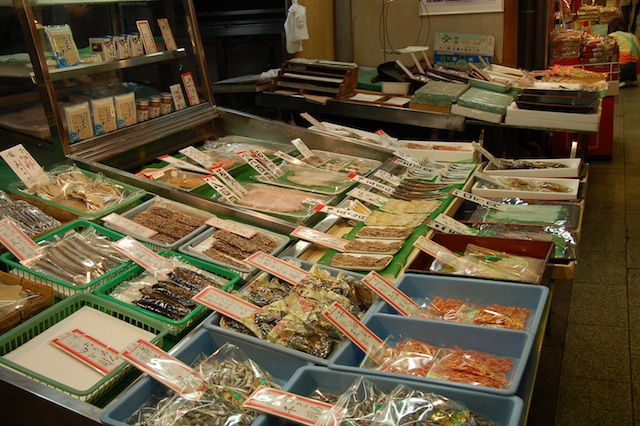I served this with cucumber with moromi miso and slices of tomatoes sprinkled with salt. This may not have been the best example of this kind of fish; it was rather on the sweet side and not as meaty or juicy as it could have been, but it was not far from what I remembered eating in a small Izakaya in Susukino 薄野. It was nostalgic and brought back memories of good times with friends. This went well with cold sake we were having.
Friday, August 5, 2011
Dried Pacific saury in mirin marinade 秋刀魚のみりん干し
No, I did not make this myself. I bought it sometime ago, frozen, and almost forgot that we had it. This is a preparation called "mirin boshi" みりん干し. Japanese love dried or semi-dried fish (This probably started out mainly as a way to preserve fish but the reduction of the water content in the fish flesh does concentrate the flavors. So now it is eaten for its taste since there are other ways to preserve fish). On our last trip to Japan, we visited stores that specialized in dried fish at the Nishiki market 錦市場 in Kyoto (picture below).

The mirin-bosh I bought was labeled as having been made in Ibaragi prefecture 茨城県. This technique of marinading in a mirin and soy sauce mixture and drying can be applied to different types of fish, for example, species of mackerel such as aji 鯵, saba 鯖, or pafici saury 秋刀魚. I recall eating it in Izakaya while I lived in Japan but they were rather sweet and often dry or even crunchy (almost candied), especially small fish like aji. I am sure if you make it at home, it may be better.

I found a package with two "sanma" fish already prepared (bone-less) in the Japanese grocery store's freezer case. I bought it for the "sake" of nostalgia (it goes well with "sake" as well). This preparation is usually grilled and served hot but some are sold already grilled (in that case, it just has to briefly warmed before serving). The one I got was not pre-grilled. After I thawed it overnight in the refrigerator, I grilled it in a toaster oven. Because of the high sugar content with mirin, it burns very easily. I lined the bottom of a baking dish with aluminum foil and placed a metal grill over it then put the mirin-boshi fish on the grill. I set my toaster oven to "broil" and started cooking the meat surface first. I carefully watched the fish as it cooked. When it started bubbling and the edges started browning I flipped the fish and continued cooking. The skin side started bubbling up and browned much faster than the meat side.
Subscribe to:
Post Comments (Atom)

1 comment:
How long do you broil each side? My wife is Singaporean and she was shopping at a local Japanese store in San Jose, CA. She bought some packages of thin, Sanma Mirin fillets. Now we are worried that they might burn if we broil in a Zojirushi fish broiler. Should we just steam them with the rice instead?
Post a Comment